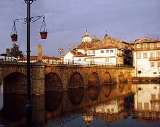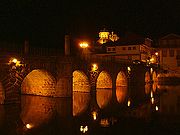
Roman bridge in Chaves
Encyclopedia
The Roman Bridge at Chaves is an ancient bridge
located in the north of Portugal
in the town of the same name
.
in Ourense
is longer and higher, this example of Roman
architecture is even today a masterpiece of construction.
Two of the columns of the original bridge, built by the Emperor Trajan
, still stand. They are stout cylindrical columns with details of the honors bestowed by the emperor on local governors or generals clearly legible on them. They were also milestones indicating distances to the important settlements of Astorga in Spanish León
and Bracara Augusta, Braga
, in Portugal.
The bridge was built between the end of the first century and the beginning of the second century AD. Little is known about the exact dates of the beginning or conclusion of construction. However, it is known that slave
s captured from the peoples inhabiting the region worked on the bridge. This appears to be written on one of the columns placed in the middle of the bridge. These columns were not here originally. One of them mentions the construction of the bridge, referring to the reign of the emperor Trajan; the other was taken from the Roman road leading up to the bridge. Before the building of the bridge the crossing was made by a road raised above the bed of the river, which only allowed the river to be crossed in summer.
Allowing the river to be crossed at any time of the year, the bridge was an important factor of development for the town, but it was also necessary and useful for the Pax Romana: here there were hot springs visited by a lot of people; in the region there were mines with precious metals, whose product was taken to Rome; across the bridge passed the important Roman road of Braga to Astorga, with a lot of traffic; and lastly here was quartered a numerous detachment of legionnaires of the Roman army.
The bridge has suffered many modifications, for restoration and conservation. The fortified tower that was built at the entrance was long ago demolished and the stone sides were substituted by iron. The span was widened and footpaths put in. The floor, originally covered by large granite blocks, now is covered by paving stones.
 A stop at the midway point to contemplate the view is highly recommendable. The scene of the river with ducks splashing in enjoyment is surprisingly bucolic, considering you are in the center of a bustling town. A park has been built along the north right bank, where the camping site used to be, and a small dam has been built south of the bridge to regulate the water. Now, even in the drought of August, there is a substantial flow of water in the river. A sewage treatment plant has finally diverted the town’s sewage from the river and fish have returned. Unfortunately, in the summer months, while before the river might slow to a trickle and Gypsies would park their wagons under the bridge to wash their clothes, now the water level remains high, but the flow of water slows considerably and the water takes on a greenish unhealthy color that is not conducive to tourism.
A stop at the midway point to contemplate the view is highly recommendable. The scene of the river with ducks splashing in enjoyment is surprisingly bucolic, considering you are in the center of a bustling town. A park has been built along the north right bank, where the camping site used to be, and a small dam has been built south of the bridge to regulate the water. Now, even in the drought of August, there is a substantial flow of water in the river. A sewage treatment plant has finally diverted the town’s sewage from the river and fish have returned. Unfortunately, in the summer months, while before the river might slow to a trickle and Gypsies would park their wagons under the bridge to wash their clothes, now the water level remains high, but the flow of water slows considerably and the water takes on a greenish unhealthy color that is not conducive to tourism.
On the south side of the bridge there is a well-kept municipal garden with a bandstand, where the town holds an annual fair of handicrafts and periodically has fairs or musical presentations. There is a small playground and a bandstand in the middle, which is rarely used. The park is an excellent place for jogging in the summer as there is a lot of shade, but in the winter the rains tend to make the dirt paths muddy. There is a project to connect this park to the other side of the river by building a footbridge
, but so far it is on the drawing table only. The land for the garden was donated by one of Chaves’ richest native sons, Cândido Pinto Souto Maior, whose house still stands on the corner across from the park. Souto Maior was a banker who became very rich in Brazil
and once owned most of the surrounding land in Madalena. His bust can be seen in the square in the park.
Roman bridge
Roman bridges, built by ancient Romans, were the first large and lasting bridges built. Roman bridges were built with stone and had the arch as its basic structure....
located in the north of Portugal
Portugal
Portugal , officially the Portuguese Republic is a country situated in southwestern Europe on the Iberian Peninsula. Portugal is the westernmost country of Europe, and is bordered by the Atlantic Ocean to the West and South and by Spain to the North and East. The Atlantic archipelagos of the...
in the town of the same name
Chaves (Portugal)
Chaves is a municipality and municipal seat of an area 10 km south of the Spanish border and 22 km south of Verín in the north of Portugal. The municipality is the second most populous of the district of Vila Real...
.
History and construction
The bridge which is in relatively good shape unites the two most important parishes in the town. The bridge is 140 meters long, high and has 12 visible arches. Although the bridge spanning the MinhoMinho River
The Minho or Miño is the longest river in Galicia, Spain, with an extension of 340 km.Both names come from Latin Minius...
in Ourense
Ourense
Ourense is a city in northwestern Spain, the capital of the province of the same name in Galicia. Its population of 108,674 accounts for 30% of the population of the province and makes it the third largest city of Galicia.-Population:...
is longer and higher, this example of Roman
Roman Empire
The Roman Empire was the post-Republican period of the ancient Roman civilization, characterised by an autocratic form of government and large territorial holdings in Europe and around the Mediterranean....
architecture is even today a masterpiece of construction.
Two of the columns of the original bridge, built by the Emperor Trajan
Trajan
Trajan , was Roman Emperor from 98 to 117 AD. Born into a non-patrician family in the province of Hispania Baetica, in Spain Trajan rose to prominence during the reign of emperor Domitian. Serving as a legatus legionis in Hispania Tarraconensis, in Spain, in 89 Trajan supported the emperor against...
, still stand. They are stout cylindrical columns with details of the honors bestowed by the emperor on local governors or generals clearly legible on them. They were also milestones indicating distances to the important settlements of Astorga in Spanish León
León (province)
León is a province of northwestern Spain, in the northwestern part of the autonomous community of Castile and León.About one quarter of its population of 500,200 lives in the capital, León. The weather is cold and dry during the winter....
and Bracara Augusta, Braga
Braga
Braga , a city in the Braga Municipality in northwestern Portugal, is the capital of the Braga District, the oldest archdiocese and the third major city of the country. Braga is the oldest Portuguese city and one of the oldest Christian cities in the World...
, in Portugal.
The bridge was built between the end of the first century and the beginning of the second century AD. Little is known about the exact dates of the beginning or conclusion of construction. However, it is known that slave
Slavery
Slavery is a system under which people are treated as property to be bought and sold, and are forced to work. Slaves can be held against their will from the time of their capture, purchase or birth, and deprived of the right to leave, to refuse to work, or to demand compensation...
s captured from the peoples inhabiting the region worked on the bridge. This appears to be written on one of the columns placed in the middle of the bridge. These columns were not here originally. One of them mentions the construction of the bridge, referring to the reign of the emperor Trajan; the other was taken from the Roman road leading up to the bridge. Before the building of the bridge the crossing was made by a road raised above the bed of the river, which only allowed the river to be crossed in summer.
Allowing the river to be crossed at any time of the year, the bridge was an important factor of development for the town, but it was also necessary and useful for the Pax Romana: here there were hot springs visited by a lot of people; in the region there were mines with precious metals, whose product was taken to Rome; across the bridge passed the important Roman road of Braga to Astorga, with a lot of traffic; and lastly here was quartered a numerous detachment of legionnaires of the Roman army.
The bridge has suffered many modifications, for restoration and conservation. The fortified tower that was built at the entrance was long ago demolished and the stone sides were substituted by iron. The span was widened and footpaths put in. The floor, originally covered by large granite blocks, now is covered by paving stones.
The bridge today

On the south side of the bridge there is a well-kept municipal garden with a bandstand, where the town holds an annual fair of handicrafts and periodically has fairs or musical presentations. There is a small playground and a bandstand in the middle, which is rarely used. The park is an excellent place for jogging in the summer as there is a lot of shade, but in the winter the rains tend to make the dirt paths muddy. There is a project to connect this park to the other side of the river by building a footbridge
Footbridge
A footbridge or pedestrian bridge is a bridge designed for pedestrians and in some cases cyclists, animal traffic and horse riders, rather than vehicular traffic. Footbridges complement the landscape and can be used decoratively to visually link two distinct areas or to signal a transaction...
, but so far it is on the drawing table only. The land for the garden was donated by one of Chaves’ richest native sons, Cândido Pinto Souto Maior, whose house still stands on the corner across from the park. Souto Maior was a banker who became very rich in Brazil
Brazil
Brazil , officially the Federative Republic of Brazil , is the largest country in South America. It is the world's fifth largest country, both by geographical area and by population with over 192 million people...
and once owned most of the surrounding land in Madalena. His bust can be seen in the square in the park.

